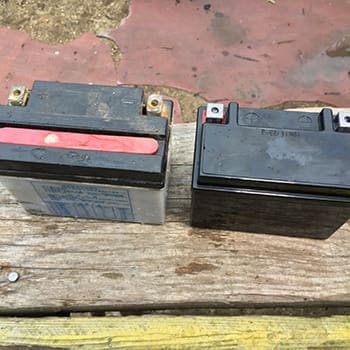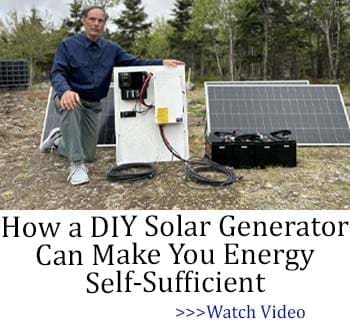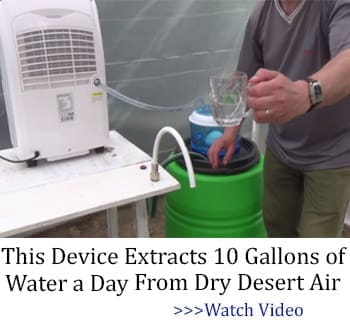We’ve all been there – your phone’s battery dies in the middle of an important call, or your car refuses to start due to a dead battery. But what happens when you’re in the middle of a crisis and you run out of electricity for your whole homestead because your batteries don’t have power anymore?
Dealing with battery issues can be incredibly frustrating, especially when you’re caught off guard.
But what if we told you that with the right practices, you can significantly extend the lifespan of your batteries? Today, I’ll provide you with actionable tips to keep your batteries going strong for longer.
How Batteries Work
At its core, a battery stores and releases chemical energy through electrochemical reactions. When a battery is connected to a device, these reactions generate an electrical current that powers the device. Over time, these reactions deplete, and the battery loses its charge, requiring recharging or replacement.
Battery Selection
Integrating hybrid systems is a smart strategy to maximize battery life and ensure a reliable power supply for your homestead. A hybrid system typically combines energy storage batteries with a backup generator or connection to the grid. This setup offers several advantages.
Firstly, it provides redundancy in power sources. During periods of low renewable energy generation, such as cloudy days for solar panels or calm days for wind turbines, a backup generator can kick in to maintain electricity production. This ensures continuous power supply to essential appliances and systems on your homestead, such as refrigerators, lighting, and communication devices.
Secondly, a hybrid system optimizes energy use based on availability and demand. It allows for seamless switching between different power sources. For instance, if your batteries are running low due to prolonged cloudy weather, the system can automatically switch to grid power or generator backup without interruption. Conversely, during periods of surplus energy generation, excess power can be stored in batteries or fed back into the grid, maximizing efficiency.
Moreover, integrating a hybrid system enhances energy independence. By combining renewable energy sources like solar and wind with a backup generator or grid connection, you can reduce reliance on external energy sources and potentially lower long-term energy costs. This approach aligns with sustainable living practices by utilizing clean energy sources while maintaining reliability through backup options.
Efficient Energy Use
Maximizing battery life through efficient inverter usage is crucial for ensuring optimal energy conversion and utilization in your homestead. Inverters play a critical role in converting the DC (direct current) power stored in batteries into AC (alternating current) power used by most household appliances and electronics.
Choosing high-efficiency inverters, especially pure sine wave models, is important. Pure sine wave inverters provide a clean and stable AC power output that is suitable for sensitive electronics like computers, televisions, and medical equipment. This ensures that your appliances operate efficiently and are protected from potential damage caused by inconsistent power supply.
Efficient inverters also minimize energy loss during the conversion process. Lower energy loss means more of the stored energy from your batteries is available for use, increasing overall system efficiency and extending battery life. This is particularly beneficial in off-grid or hybrid systems where energy conservation is essential to prolonging battery cycles and reducing maintenance costs over time.
Additionally, matching the size and capacity of the inverter to your power requirements is crucial. Oversized inverters may consume more standby power and operate less efficiently at lower loads. On the other hand, undersized inverters may struggle to meet peak demand, potentially causing inefficiencies or even equipment failures.
Energy Storage Management
To maximize battery life for your homestead, consider integrating hybrid systems that combine batteries with a backup generator or the grid. This approach ensures a continuous power supply and optimizes energy use by switching between different sources based on availability and demand.
Using high-efficiency inverters, preferably pure sine wave models, minimizes energy loss during the conversion from DC to AC power. This makes more stored energy available for household use, improving overall system efficiency.
Adopting effective battery storage strategies is crucial. Limit the depth of discharge (DoD) to extend battery life and maintain the state of charge (SoC) within an optimal range, ideally between 20% and 80%. These practices help prevent battery degradation and prolong their lifespan.
Monitoring and control systems are essential for efficient energy management. A Battery Management System (BMS) ensures balanced charging and discharging, preventing overcharging and deep discharging. An Energy Management System (EMS) can automate and optimize energy use across your homestead, prioritizing critical loads during low-energy periods.
Lastly, integrating renewable energy sources like solar panels and wind turbines with efficient charge controllers enhances energy storage. Use Maximum Power Point Tracking (MPPT) charge controllers for solar systems to optimize energy transfer and storage, and ensure wind turbine controllers manage energy generation efficiently. These strategies collectively ensure a reliable and sustainable power supply for your homestead.
Monitoring and Control Systems
Effective monitoring and control systems are essential for optimizing energy storage and maximizing battery life in your homestead. A Battery Management System (BMS) plays a crucial role in ensuring the health and longevity of your battery bank. It monitors key parameters such as voltage, current, temperature, and state of charge (SoC) of individual battery cells.
By continuously monitoring these parameters, the BMS can prevent issues such as overcharging, deep discharging, and imbalance among battery cells. This proactive management not only extends the lifespan of your batteries but also enhances their overall performance and reliability.
In addition to the BMS, implementing an Energy Management System (EMS) provides further benefits. An EMS optimizes energy use across your homestead by prioritizing critical loads and adjusting power consumption based on available energy and demand. It can automate tasks like switching between power sources (e.g., batteries, grid, renewable sources) and scheduling operations to minimize energy wastage.
Moreover, modern monitoring systems often include remote access and real-time data logging capabilities. This allows you to track energy production, consumption patterns, and system performance over time. Analyzing this data helps in identifying potential energy-saving opportunities, optimizing system configurations, and planning for future upgrades or maintenance.
Overall, investing in robust monitoring and control systems like BMS and EMS ensures efficient management of your energy storage system. It not only maximizes battery life and enhances system reliability but also empowers you to make informed decisions to optimize energy usage and reduce operational costs over the long term.
Renewable Energy Integration
Integrating renewable energy sources such as solar panels and wind turbines with your battery storage system is pivotal for sustainable energy management on your homestead. These renewable sources provide clean and often cost-effective energy, reducing your reliance on traditional fossil fuel-based power sources and contributing to environmental conservation.
Solar panels, for instance, harness sunlight and convert it into electricity through photovoltaic cells. When integrated with an efficient charge controller, such as Maximum Power Point Tracking (MPPT), solar systems optimize energy harvesting by adjusting the panel’s operating point to maximize power output. This not only enhances energy production but also ensures efficient charging of your battery bank.
Related: 8 Solar Powered Items You Should Have on Hand
Similarly, wind turbines capture kinetic energy from the wind and convert it into electrical power. Wind energy can be particularly beneficial in areas with consistent wind patterns. Proper integration with the battery system involves using suitable controllers to regulate turbine operation and manage energy flow, ensuring optimal battery charging and system stability.
Furthermore, integrating renewable energy sources offers greater energy independence. It allows you to generate your own electricity, reducing or even eliminating electricity bills from grid usage. Excess energy generated can be stored in batteries for use during periods of low renewable energy production or exported back to the grid, depending on your setup and local regulations.
Consult your device’s manual or the battery manufacturer’s recommendations for guidance on when to replace the battery based on its age or usage cycles.
By following these tips and practices, you can significantly extend the lifespan of your batteries, saving you money and reducing waste.
Not only does maximizing battery life provide convenience, but it also has positive environmental impacts by reducing the demand for new battery production and minimizing improper disposal.
What did I forget? Share additional tips and personal experiences below!
Modular Backyard Power Plant Review
Why You Should Never Hide Your Stockpile In Your Basement (Video)
Amish Powerless Tools For A World Without Power











